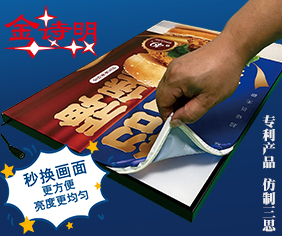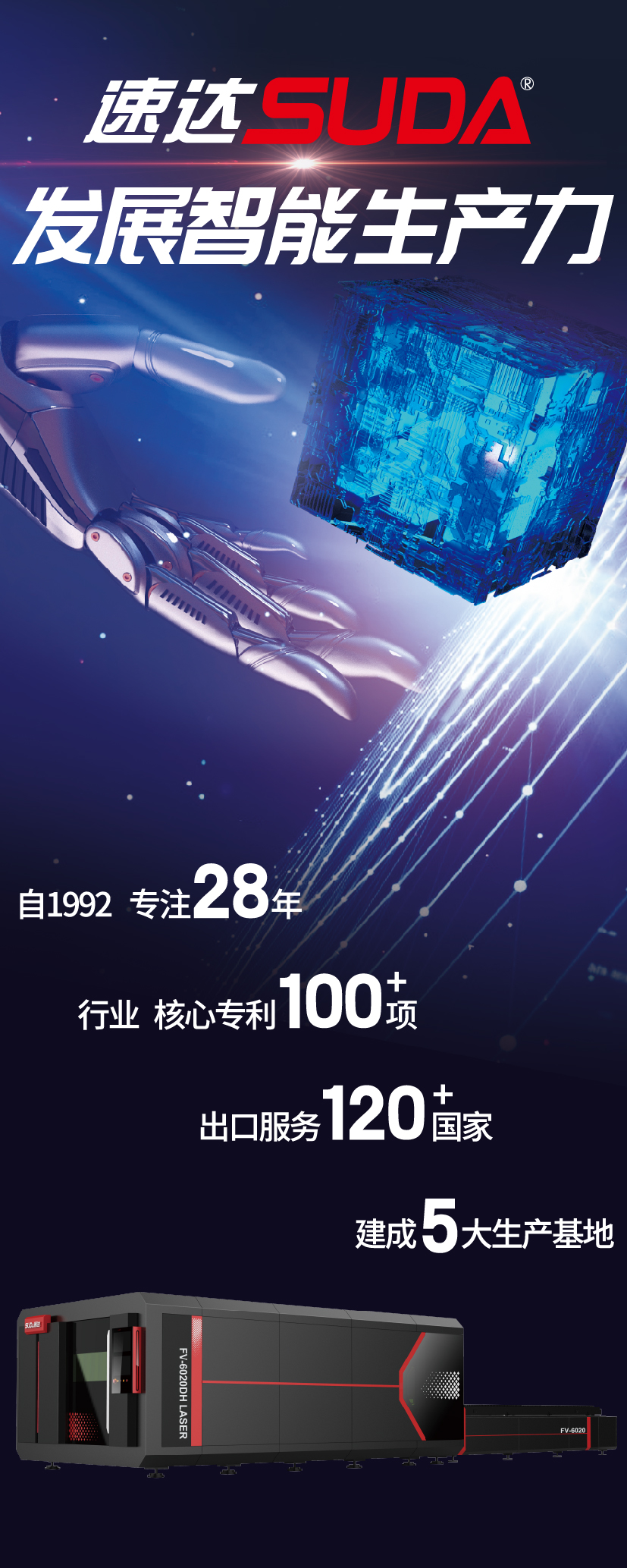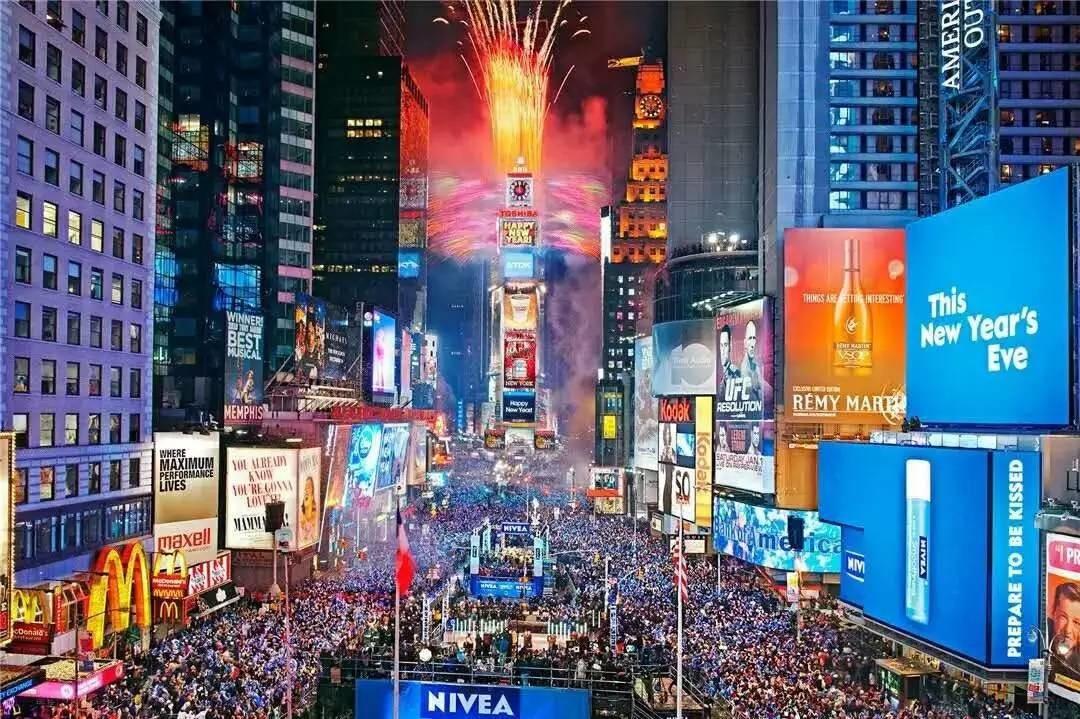
Now with LED video screens comes the outdoor advertising impulse to create the ultimate building wrap, a media facade, which is an LED video screen that completely covers the front of a building and presents a kaleidoscope of imagery that dances across the building.
户外LED大屏幕现已成为户外广告最流行建筑包装,它是一个以LED为基础,可以在建筑物上呈现各种图像的新兴广告载体。
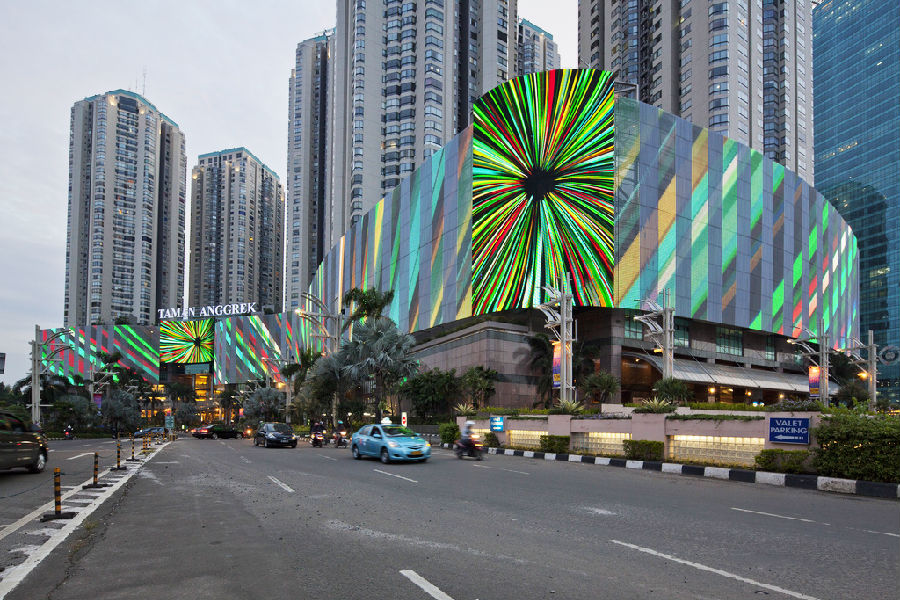
Media facade building skins has given architecture a new thematic development where the video cladding's has become the "voice" of the building's corporate identity. Such dynamic video coverage gives the building a dream-like presence as its pictorial content swirls around its exterior walls. Video-covered buildings were first foretold in Blade Runner, Ridley Scott's 1982 film polemic on androids (artifice humans) and their place in society. As the movie unfolded across its futuristic city-state, film viewers were able to glimpse examples of video screens attached to several buildings and integrated within the city's skyline.
户外LED大屏幕给建筑带来了一个全新的主题,它已成为建筑企业形象的“声音”。因为企业可以通过建筑外墙展示广告等画面内容,所以这种动态视频给路过的人带来了梦幻般的景象。影片《银翼杀手》首次预言了有户外LED大屏幕的建筑,这是雷德利•斯科特于1982年拍摄的电影,在影片中,观众能够看到连接在几栋建筑上的户外LED大屏幕。
Today, outdoor video cladding is a practical, though an expensive possibility in how a modern building can digitally present itself. The use of video as a cladding is both a victory for architects and for advertisers. Because of the flexible nature of LEDs, it is inevitable that it would eventually become an architectural 'surface application' with great appeal to building designers. Esthetically, media facades have created a dynamic building effect that radiates programmable light and video graphics to represent its tenants and visually showcases their brands and products on the building's video screens. For building owners, it becomes an obvious additional revenue and a source of pride with their building's lit-up video walls easily dominating the surrounding skylines and becoming a tourist destination in its own right.
现如今,户外LED大屏幕是一种流行的建筑设计,只是现代建筑数字化的成本非常高昂,但对于建筑师和广告商来讲,户外LED大屏幕是一种双赢。LED因其灵活性成为建筑师应用于设计的一大特色,从美学上讲,户外LED大屏幕创造了一种动态的建筑效果,通过可编程的光线和视频图形来成为一种新型传播载体,并在建筑物的视频屏幕上直观地展示他们的品牌和产品。对于建筑物业主来说,它成为一个明显的额外收入,户外LED大屏幕很容易把建筑物本身打造成一个热门旅游目的地。

Currently there are at least thirty or more skyscrapers worldwide that have embraced media facade video walls in some form in their building frontage. As you'd expect, this architectural phenomena began in Times Square and has now migrated overseas to major European and Asian urban centers as well. Image content on these super-sized buildings vary, some are billboards, but others are more subtle and combine branding and art to brighten up the surrounding cityscape.
目前,全世界至少有三十个或更多的摩天大楼在其建筑物正面采用户外LED大屏幕。这种建筑现象始于时代广场,现在已经向欧洲和亚洲城市中心迁移。这些超大型建筑的形象内容各不相同,有些是广告牌,但有些微妙的将品牌和艺术结合起来,成为照亮周围的城市景观。
In 1998, the Taiseido Building (Tokyo) main tenant, QFRONT, sponsored a huge video screen 23.5 x 19 meters that covered much of the front of that building. Located in the Shibuya district, one awe-struck viewer described how the three gigantic video displays drew the attention of virtually every pedestrian and passerby who saw the building. You could expect to see any number of programming types on the walls, ranging from the top 10 music video countdown to the occasional weather report rundown. In Seoul, South Korea in 2004, the Galleria West was covered with thousands of LED frosted diachronic disks creating a building that radiated both a multi-color light show and a series of streaming text messages for passing vehicular traffic.
1998年,Taiseido 建筑公司(东京)QFRONT赞助了一个23.5 x 19米的巨幅户外LED大屏幕,它能覆盖建筑的大部分正面。位于涩谷区的一名观众惊叹地描述了这三个巨大的视频显示屏是如何吸引每一个行人的注意力的。你可以在墙上看到各种各样的画面类型,从排名前十的音乐视频到天气预报。2004年,在韩国首尔,设计师把Galleria商场大楼打造成被无数个LED磨砂光盘覆盖的建筑,创造了一个既能展示多色灯光秀又能为过往车辆提供一系列流媒体信息的城市景观。

Times Square: Birthplace of video cladded buildings
时代广场:户外LED大屏幕的诞生地
The first instance of video cladding was introduced in Times Square in 1999 with the NASDAQ Marketsite building which was covered with a 10-story video wall. Gary Nalven, Co-CEO, Saco Smartvision the company that provided the LED screen for NASDAQ, noted, "The NASDAQ's building LED screen has become a fantastic symbol of the financial community, in some ways replacing the Wall Street image of its Roman column building. A day doesn't go by in Times Square where NASDAQ isn't being photographed or videoed by the international media as a backdrop for their reporters."
第一个户外LED大屏幕于1999年在时代广场推出,纳斯达克市场大楼覆盖着一个10层楼高的视频墙。为纳斯达克提供LED屏幕的中美合作所首席执行官加里•纳尔文说:“纳斯达克的户外LED大屏幕已成为金融界的一个神奇象征,在某种程度上取代了罗马建筑在华尔街的形象。”在时代广场,纳斯达克每天都会被国际媒体拍照和摄像。
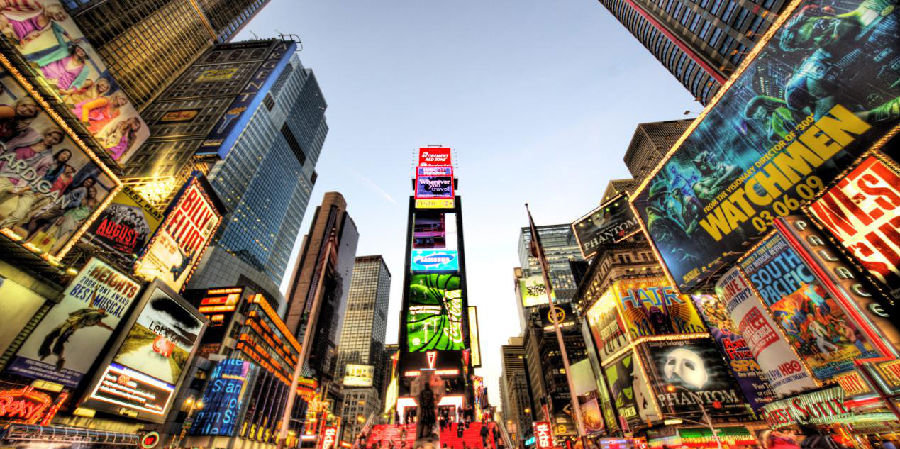
Shortly thereafter, also in 1999, the ABC News (owned by the Walt Disney Company) building emerged with nine separate ribbons of full color, programmable LED displays. Each ribbon is approximately 133 feet of horizontal bends and curves all undulating around the front of the ABC News building. George Sugarman, former president of Multimedia, the company that designed the LED spectacular noted that the ABC News video display was so large that it becomes as much the front of the building as it is a sign.
同在1999年,ABC新闻(由华特迪士尼公司所有)大楼出现了9个独立的全彩色可编程户外LED大屏幕。每个显示屏大约133英尺,它们可以水平弯曲并且围绕着ABC新闻大楼的前面起伏。设计这一户外LED大屏幕的多媒体公司前总裁乔治•休格曼指出,美国广播公司新闻频道(ABC News)的视频显示屏非常大,它既是大楼的标识,也是大楼的门面。
“The building's LED video cladding,” stated Susan Bonds, Disney show producer for the sign, “has became a premiere benchmark of how the exterior LED sign melded architecture, media and entertainment into a single integrated design. We now have a sculptural LED display board that conforms to the building and is constantly changing its look from minute to minute." Since then, other local Times Square buildings have employed similar full building coverage including the Lehman Brothers Building and the Reuters Building.
迪士尼节目制作人苏珊·邦兹说:“这栋建筑的户外LED大屏幕已成为标志性的存在。建筑、媒体和娱乐成为设计的首要基准。我们现在拥有一个符合建筑风格的户外LED大屏幕,每分钟都在不断地改变它的外观。从那以后,时代广场的其他建筑也采用了类似的设计,包括雷曼兄弟大楼和路透社大楼。”

One persistent challenge with media facade screens covering a building is how to effectively use the LED video screen in a way that it acts as both a video display and as a window. The challenge is to present graphic and video images but to do so without blocking ambient daylight from the building's windows and glass walls. All previous Times Square buildings using LED screens did so by covering dedicated windowless, wall spaces along the building. In the case of the NASDAQ building window slots were actually built into the screen face.
业主面临户外LED大屏幕的一个挑战是如何有效地使用它,使其既能发挥广告的功能又能作为办公室的窗户使用。也就是说在呈现图形和视频图像的同时,又不能阻挡建筑物窗户和玻璃墙周围的光线。以前时代广场上所有使用户外LED大屏幕的建筑都是通过采用专门的无窗墙壁空间来实现的。在纳斯达克大楼的例子中,窗口实际上是被遮盖在屏幕里的。
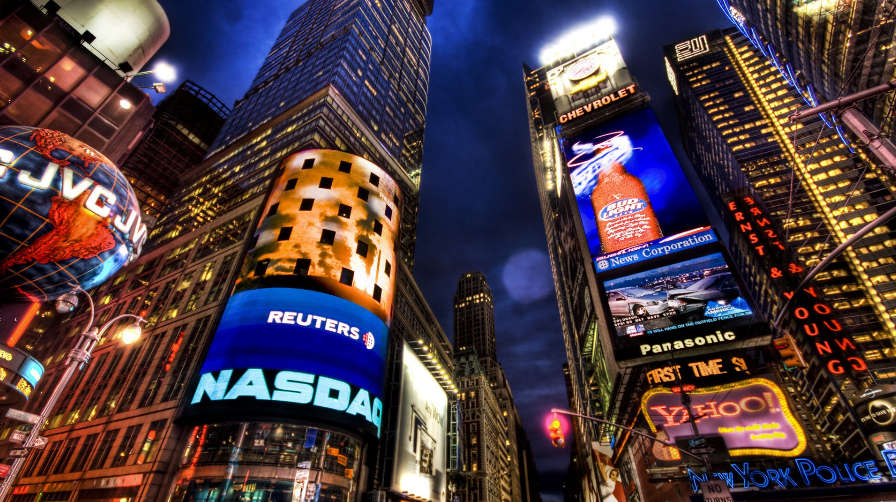
Grand Indonesia tower as beacon of light
被誉为“光之塔”的大印尼塔
Perhaps the most spectacular video cladding applied to a building is on The Grand Indonesia Tower which is under construction in Jakarta, Indonesia. The 3.7 million square foot mixed-use center features retail, a hotel, and as its centerpiece: a 57-story office tower. The building was created by Darryl Yamamoto, AIA, of AVRP, Los Angeles (Austin Veurn Robbins Partners), who was formerly with RTKL, where he designed and now describes the project. "Essentially the LED grid followed the form of the building's curtain wall. Thus the LED video strips were mounted against the building in several types of formations. In some instances where there was glass, the LED video strips were placed inside the glass facing outwards towards the public. Where there were opaque, metal panels on the building skin, the LED strips were recessed into reveals."
也许在建筑中最壮观的户外LED大屏幕是印度尼西亚雅加达正在建造的大印尼塔。这个370万平方英尺的综合体包括零售、酒店和57层的办公大楼。该建筑由Darryl Yamamoto, AIA设计,来自洛杉矶AVRP (Austin Veurn Robbins Partners),他之前在RTKL工作,在那里他设计了这个项目。户外LED大屏幕基本上遵循了建筑幕墙的形式。因此,LED以不同的形式安装在建筑物上。在一些有玻璃的情况下,LED会被放置在玻璃内部。“

In total, the entire front facade of the Grand Indonesia Tower is covered with at least 60,000 square feet of LED arrays. The building is designed with several LED screens, including an LED lighting effect on the crown of the building and its video screen on the entire front of the building, The Grand Indonesia's sidewalls will also be emblazed with LED lighting that will act as visual attractors to draw people's attention to the front of building displays. While just lighting up buildings with LEDs has become very che-che with architects, it's a smaller number of visionary building developers who see the value of video walls as part of their building design. Ideally, a perfect building design would combine both of these elements (lighting and video) into a complete visual motif of how the building would shine.
总的来说,整个大印尼塔的正面覆盖着至少60,000平方英尺LED大屏幕,大屏幕遍布在塔尖和四周,大屏幕发出闪耀的光芒吸引着每一个观看大印尼塔的人。虽然用LED已经成为建筑师们的时髦,但只有少数富有远见的建筑开发商将户外LED大屏幕的价值视为他们建筑设计的一部分。一般情况下,一个完美的建筑设计应该将灯光和视频这两种元素结合在一起,形成一个完整的视觉主题。
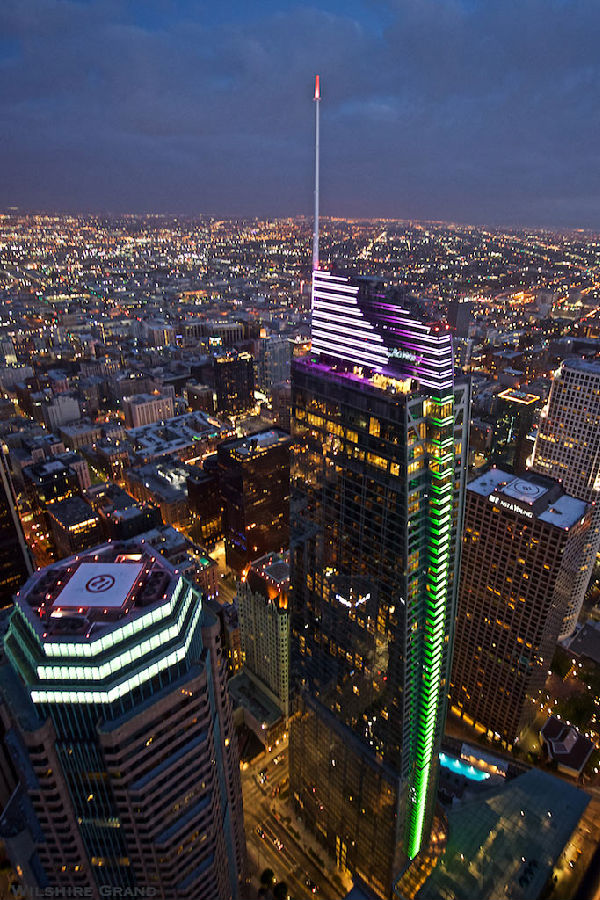
Yamamoto observed that a building's identity is normally defined by its exterior shape and in some instances, the use of exterior lighting that emphasizes that shape. "Up to now architecture has been about fitting buildings into three-dimensional space. The inclusion of video screens completely covering a building's surface changes that equation of how a building occupies that space. In a sense, video screen coverage on a building surface places it in a fourth dimension where pictorial and iconic imagery now become a representational feature of how the building presents itself."
Yamamoto观察到建筑物名称通常由其外部形状定义,在某些情况下,外部照明起到了强调建筑物外形的作用。到目前为止,建筑一直是将建筑物置于三维空间中,户外LED大屏幕改变了建筑物如何占据空间的等式。从某种意义上说,建筑物表面的视频屏幕覆盖将其置于第四维度,图像和标识成为建筑物展现自身的代表性特征。“
Adrian Velicescu, CEO of StandardVision, LLC (LA, CA), whose company develops architecturally integrated multimedia and media facade installations in creative ways of bringing audiences and brands together. Under this charter StandardVision both designed the video screen and developed the content strategy and media business model for The Grand Indonesia Tower. "This building is not only the largest skyscraper in Jakarta," he noted, "but upon completion, its video screen (96-feet wide by 450 feet tall) will be the largest media display in the world." The TransMedia (TM) integrated display was designed by StandardVision as an internal sunshade system and is featuring LED technology by Imago (Barcelona, Spain) formerly known as Odeco.
Adrian Velicescu是StandardVision,LLC(洛杉矶,加利福尼亚州)的首席执行官,他的公司开发了建筑一体化的多媒体和户外LED大屏幕装置,以创造性的方式将观众和品牌聚集在一起。根据这份章程,StandardVision设计了户外LED大屏幕,并为大印尼塔开发了内容策略和媒体业务模式。 “这座建筑不仅是雅加达最大的摩天大楼。”他说,“完工后,它的视频屏幕(96英尺宽,450英尺高)将成为世界上最大的媒体显示屏。”TransMedia (TM)集成显示器是由StandardVision设计的一个内部遮阳系统,采用Imago(西班牙巴塞罗那)的LED技术,前身为Odeco。
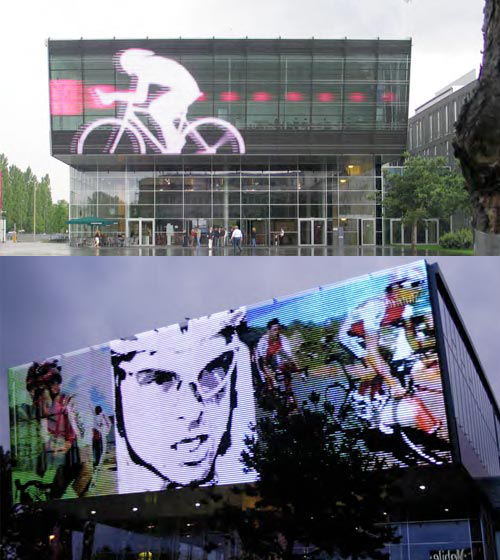
Velicescu stated that, "Very large video screens are not just billboards. These screens also have a social responsibility to offer a 'civil function' beyond just advertising and branding messages. There is also kinetic art and socially relevant iconic graphics that are a part of what will be sown on the building face. We believe that content should have some direct relationship to its surrounding community. We perceive about 50% of the building's sign content will be revenue based and the other half will be public service announcements and art. All of this content will be designed with a natural visual pacing to make it compelling and more universally accepted by its viewing audiences.
Velicescu说:“户外LED大屏幕不仅仅是广告牌,这些屏幕还承担着社会责任,提供除了广告和品牌信息之外的'民用功能'。还有动态艺术和社会相关的图形,我们相信内容应该与周围的社区有一些直接关系。该建筑50%的屏幕将以收入为基础,另一半将是公共服务公告和艺术信息,所有这些内容采用自然的视觉节奏,让它们更好的被观众接受。”
Ag4 and Mediamesh
Ag4公司与Mediamesh
In searching for an optimal balance between architecture and media, a company known as ag4 (Cologne, Germany) which is an interdisciplinary group of architects, artists, and industrial designers conceived a breakthrough idea of integrating transparent LED video screens to both cover a building facade and, and do so without blocking ambient exterior light from entering the building. Christoph Kronhagel, ag4 co-founder and co-inventor of their LED video wall explained, "The big challenge in using LED screens architecturally is how the screens would esthetically be integrated into the building form. Our solution was to design a linear LED video component into a metal mesh and hang it off the side of the building, where it becomes a transparent media curtain wall that hangs in front of the building cladding." According to ag4's technical briefing, despite the linear separation of each LED video array, when seen from a distance of 60 feet or more, the human eye fills in the visual gaps between each LED strip and allows the viewer to see a completely discernable image.
一家名为ag4(德国科隆)的公司是一个由建筑师,艺术家和工业设计师组成的跨学科团队,为了寻求建筑与媒体之间的最佳平衡,他们构思了一个突破性的想法,即将透明LED视频屏幕整合到建筑上,在不阻挡环境外部光进入建筑物的情况下使用户外LED大屏幕。他们的LED视频墙联合创始人兼联合发明人Christoph Kronhagel解释说:“在结构上使用户外LED大屏幕的最大挑战是如何将屏幕美学融入建筑里面。我们的解决方案是设计线性LED模组进入金属网并将其悬挂在建筑物的侧面,在那里它成为一个透明的户外LED大屏幕。“根据ag4的技术简报,尽管每个LED模组呈线性分离,但当从60英尺或更远的距离观看时,人眼会填充每个LED模组之间的视觉间隙,并能够让观看者看到完全可辨别的图像。
"The beauty of this idea is that using metal woven mesh is an already accepted architectural design look. To complete this process into an actual usable architectural/signage design element, we collaborated with GKD (Düren, Germany), a manufacturer of metal woven building mesh. Together we created Mediamesh®, a transparent covering that both radiates video imagery and is transparent to passing ambient daylight into the building." ag4 describes this expressive design form as 'mediatecture' where a client is able to visually present their brand or corporate identity on the building exterior facade.
“这个想法的绝妙之处在于,金属编织网是一种已经被接受的建筑设计外观材料。为了将这个过程变为实际可用的建筑标识设计,我们与GKD(德国Düren)合作,这是一家金属编织建筑制造商,我们一起创造了Mediamesh。Mediamesh是一种透明的遮盖物,既可以投射视频图像,也可以让阳光透过玻璃进入建筑物。“ ag4将这种富有表现力的设计形式描述为“mediatecture”,客户能够在建筑外表面上直观地展示他们的品牌或企业形象。
ag4's first Mediamesh installation was placed on the T-Mobile headquarters in Bonn, Germany. Here 300 square meters of Mediamesh were applied to the front of its building (30 meters wide x 10 meters tall) with 12 centimeter spacings between each row. Once in place on the building, the screen presented a complete low resolution, full color video image viewable in daylight or evening directly from the building wall. As a new medium, these screens become more than just signs says Kronhagel, "The use of video walls also brings a public service component to the mesh display with not only advertising and branding, but also art and culture. At some point the use of the screens becomes collaboration between the building's tenants and the surrounding community to present a 'world view' of what they're about to."
ag4的第一个Mediamesh安装位于德国波恩的T-Mobile总部。300平方米的Mediamesh安装在总部大楼的前部(30米宽×10米高),每排之间有12厘米的间距。Mediamesh一旦安装在建筑物上,屏幕就会呈现出一个低分辨率的全彩视频图像,人们可以在白天或晚上直接从建筑物的墙壁上看到。Kronhagel说:“作为一种新的广告载体,这些屏幕不仅仅是标识,户外LED大屏幕的使用还为社会带来了公共服务功能,这里不仅展示广告和品牌,还有艺术和文化。”在某种程度上,屏幕的使用促进了建筑租户和周围社区之间的合作,以展示他们即将要做的事情。
The creation of such a media mesh wall begins with the weaving together of the mesh covering. In the creation of the covering, steel sleeves are inserted at specific points within certain rows of the mesh. The sleeves are holders for a series of 'transparent aluminum profiles filled with RGB LEDs and covered to with a waterproof resin. Each aluminum module is a linear array segment of an RGB LED video display. Upon completion, the mesh structure holds a complete LED video matrix that is inserted in rows of the Mediamesh set at specific distances (depends on the height of the windows in the building), which depend on the total height of the screen that will be fitted on the build facade. Depending on the project the LED pitch can be between 4 to 40 centimeter spacing. The mesh can be designed to any length and can be set anywhere up to 26-foot wide width. The video control center can be independent of the building's location thus the building screen can be managed via the Internet.
想要制造这样一个户外LED大屏幕首先要创建覆盖物,钢套管被插入网格中某些特定的点上。套管是透明铝型材填充RGB LED,并覆盖有防水树脂。覆盖物制作完成后,网状结构将保存一个完整的LED模组,该模组插入Mediamesh设置的特定距离中,特定距离取决于将安装在建筑立面上的屏幕的总高度。根据项目的不同,LED间距可以在4到40厘米之间。网格可以设计成任意长度,可以设置在宽度达26英尺的任何地方。视频控制中心可以独立于建筑物的位置,因此可以通过互联网管理建筑物屏幕。
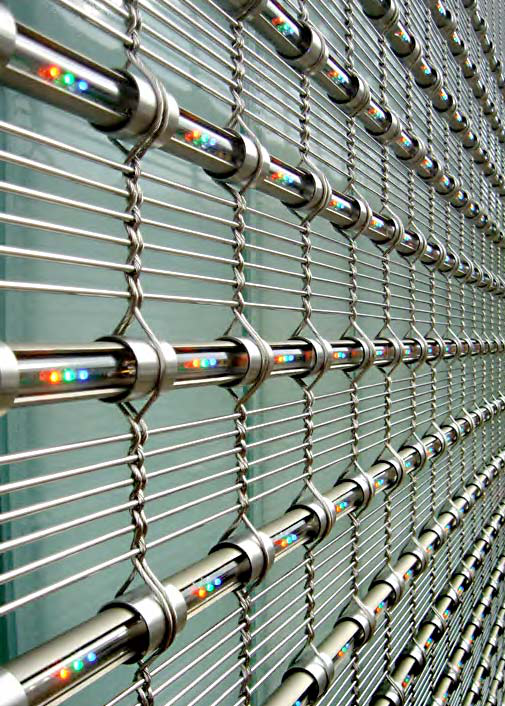
Mediamesh has two functions, to be transparent during the day to allow sunlight to illuminate the interior office space and equally so, to transmit day or evening a video image across the front of the building. Viewed close up, these image segments may not visually seem like much of anything, but when viewed from a distance, the segments blend together into a completely discernable video image. As a rule, the viewing distance is self selective, if the viewer gets to close to the screen, they'll back up until the image is at a viewable resolution. Mediamesh video screens are versatile and can accept varied content between text, graphics and video imagery. With the right software, it is also possible to present live video on the screen. A secondary effect, when the Mediamesh is not in use, it appears as an unobtrusive and decorative light-reflecting screen as part of the building facade. Mediamesh can also present live video which requires specialized hardware and a more integrated high resolution video display.
Mediamesh有两个功能,一是它在白天是透明的,可以让阳光照亮内部办公空间;二是它也可以在建筑物的正面传输视频图像。如果观看者距屏幕太近,他们就必须后退至一定距离直到图像处于可视分辨率状态下才可以看清。Mediamesh视频屏幕功能多样,可以接受文本、图形和视频图像之间的各种内容。使用合适的软件,还可以在屏幕上显示实时视频。第二种效果,当Mediamesh不使用时,作为建筑大屏幕的一部分,它看起来像一个不显眼的装饰性光反射屏幕。Mediamesh还可以呈现实时视频,这需要专门的硬件和更集成的高分辨率视频显示屏幕。
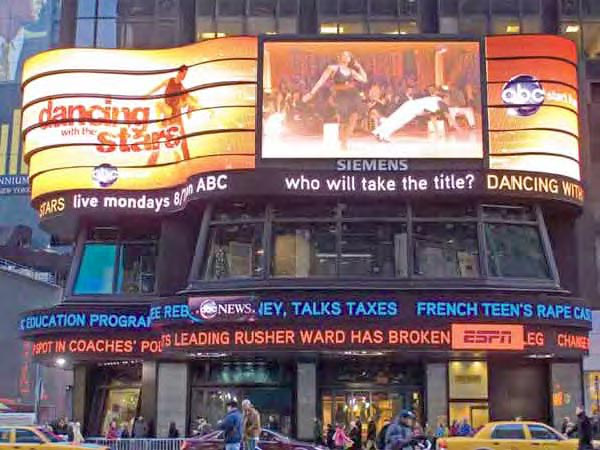
Producing a Mediamesh wall in some ways is no different than planning for a static sign or print billboard; location is everything. This applies to how the building faces oncoming pedestrian and vehicular traffic, also in determining the screens proper sightline for ease of viewing from the street. If the screen is high enough, not only can the street see it, so can surround buildings. Aside from buildings, Mediamesh is also appropriate for sport stadiums and arenas, casinos and convention centers, just about any public gathering space where large video screens are needed to transmit pictures, graphics and text.
在某些方面看来,制作Mediamesh墙与规划静态标识或印刷广告牌没有什么不同,因为最重要的是安装位置。建筑物标识的位置要迎合迎面而来的行人和车辆,以便在适当的视距从街道观看。如果屏幕足够高,那在街道的各个角落都可以看到它。除了建筑物,Mediamesh也适用于体育场馆、竞技场、赌场和会议中心,几乎适用于所有需要大型视频屏幕展示图片、图形和文本的公共聚会场所。





